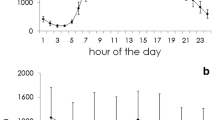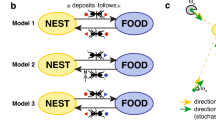Abstract
We quantitatively studied movement behaviour in the gastropod Littorina littorea in laboratory experiments during periods of their non-mating season (November 1992) and their mating season (April–May 1993). Snails were collected in 1992 and 1993 from one boulder shore on the north west coast of Sweden. In a comparison between the two seasons (one non-mating and one mating) we measured trail complexity of unsexed snails using fractal dimesion, the degree of mucus trail following (coincidence index of marker and tracker trails) and average movement speed of marker and tracker snails. We found no differences in fractal dimension and coincidence index of trails between the two seasons. Tracker snails moved, however, significantly faster than marker snails during both seasons. This could not be explained by trackers, when locomoting, using the mucus trail deposited by the marker to increase their speed, since there was no correlation between coincidence index and tracker speed. During the mating season we also conducted trail complexity, trail following and speed experiments comparing the behaviour of males and females. There was no difference between males and females in the fractal dimension of movement, nor was there any difference between the mean speed of male and female snails, although male marker snails tended to move faster than female marker snails. Males tracking other males, females tracking other females and females tracking males followed trails about equally long distances (i.e., coincidence indices did not differ). In contrast, males following female mucus trails showed a significantly higher degree of trail following than the other sex combinations. This new finding may suggest that females of L. littorea release pheromones in their mucus trails and that males are able to identify them.
Similar content being viewed by others
References
Bovet P, Benhamou S (1988) Spatial analysis of animals' movements using a correlated random walk model. J theor Biol 131:419–433
Bretz DD, Dimock RV Jr (1983) Behaviorally important characteristics of the mucous trail of the marine gastropod Ilyanassa obsoleta (Say.) J exp mar Biol Ecol 71:181–191
Chapman MG, Underwood AJ (1992) Foraging behaviour of marine benthic grazers. In: John DM, Hawkins SJ, Price JH (ed) Plant-animal interactions in the marine benthos. Clarendon Press, Oxford, pp 289–317
Croll RP (1983) Gastropod chemorception. Biol Rev 58:293–319
Curtis LA (1993) Parasite transmission in the intertidal zone: vertical migrations, infective stages, and snail trails. J exp mar Biol Ecol 173:197–209
Davies MS, Jones H, Hawkins SJ (1992) Pedal mucus production in Littorina littorea. In: Grahame J, Mill PJ, Reid DG (eds) Proceedings of the third international symposium on littorinid biology, Dale Fort, Wales, 5–12 Sep 1990. The Malacological Society of London, London, pp 227–233
Dicke M, Burrough PA (1988) Using fractal dimensions for characterizing tortuosity of animal trails. Physiol Entomol 13:393–398
Dinter I (1974) Pheromonal behaviour in the marine snail Littorina littorea Linnaeus. Veliger 17:37–39
Duncan A, Klekowski RZ (1975) Parameters of an energy budget. In: Grodzinski W, Klekowski RZ, Duncan A (eds) Methods for ecological bioenergetics. Blackwell Scientific Publications, Oxford, pp 97–147
Erlandsson J, Johannesson K (1994) Sexual selection on female size in a marine snail, Littorina littorea (L.). J exp mar Biol Ecol 181:145–157
Fretter V, Graham A (1980) The prosobranch molluscs of Britain and Denmark. J Moll Stud Suppl 7. The Malacological Society of London, London
Frontier S (1987) Applications of fractal theory to ecology. In: Legendre P, Legendre L (eds) Developments in numerical ecology. Springer-Verlag, Berlin, NATO ASI Series G14, pp 335–378
Gilly WF, Swenson RP (1978) Trail following by Littorina: washout of polarized information and the point of paradox test. Biol Bull mar biol Lab, Woods Hole 155:439
Hughes RN (1980) Optimal foraging theory in the marine context. Oceanogr mar Biol A Rev 18:423–481
Hughes RN, Answer P (1982) Growth, spawning and trematode infection of Littorina littorea (L.) from an exposed shore in north Wales. J molluse Stud 48:321–330
Imrie DW (1992) The role of pedal mucus in the feeding behaviour of Littorina littorea (L.). In: Grahame J, Mill PJ, Reid DG (eds) Proceedings of the third international symposium on littorinid biology, Dale Fort, Wales, 5–12 Sep 1990. The Malacological Society of London, London, pp 221–226
Mandelbrot BB (1977) Fractals, form, chance, and dimension. Freeman & Co, San Francisco
Mandelbrot BB (1982) The fractal geometry of nature. Freeman & Co, San Francisco
Loehle C (1990) Home range: a fractal approach. Landscape Ecol 5:39–52
Newell GE (1958) The behaviour of Littorina littorea (L.) under natural conditions and its relation to position on the shore. J mar biol Ass UK 37:229–239
Petraitis PS (1982) Occurrence of random and directional movements in the periwinkle, Littorina littorea (L.). J exp mar Biol Ecol 59:207–217
Raffaelli DG (1977) Observations of the copulatory behaviour of Littorina rudis Maton and Littorina nigrolineata Gray (Gastropoda: Prosobranchia). Veliger 20:75–77
Raftery RE (1983) Littorina trail following: sexual preference, loss of polarized information, and trail alterations. Veliger 25: 378–382
Saur M (1990) Mate discrimination in Littorina littorea (L.) and L. saxatilis (Olivi) (Mollusca: Prosobranchia). Hydrobiologia 193:261–270
Stirling D, Hamilton PV (1986) Observations on the mechanism of detecting mucous trail polarity in the snail Littorina irrorata. Veliger 29:31–37
Struhsaker JW (1966) Breeding, spawning periodicity and early development in the Hawaiian Littorina: L. pintado (Wood), L. picta Philippi and L. scabra (Linné). Proc malac Soc Lond 37:137–166
Tankersley RA (1989) The effect of trail-following on the locomotion of the marsh periwinkle Littorina irrorata (Mesogastropoda: Littorinidae). Mar Behav Physiol 15:89–100
Townsend CR (1974) Mucous trail following by the snail Biomphalaria glabrata (Say.) Anim Behav 22:170–177
Underwood AJ (1981) Techniques of analysis of variance in experimental marine biology and ecology. Oceanogr mar biol A Rev 19:513–605
Wells MJ, Buckley SKL (1972) Snails and trails. Anim Behav 20:345–355
Author information
Authors and Affiliations
Additional information
Communicated by T. M. Fenchel, Helsingør
Rights and permissions
About this article
Cite this article
Erlandsson, J., Kostylev, V. Trail following, speed and fractal dimension of movement in a marine prosobranch, Littorina littorea, during a mating and a non-mating season. Marine Biology 122, 87–94 (1995). https://doi.org/10.1007/BF00349281
Received:
Accepted:
Issue Date:
DOI: https://doi.org/10.1007/BF00349281




